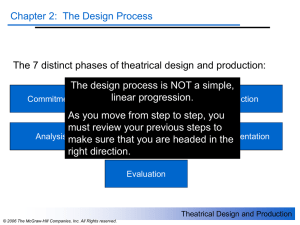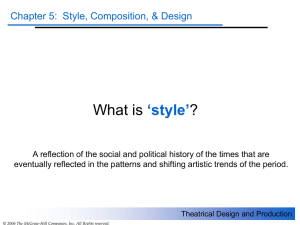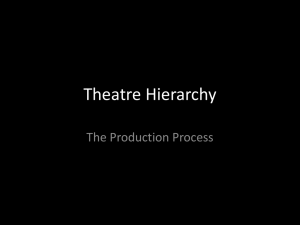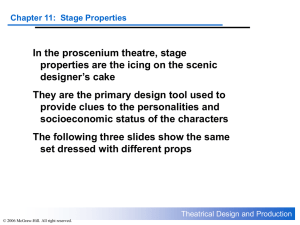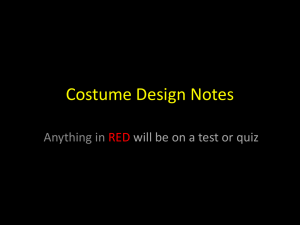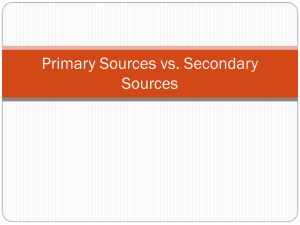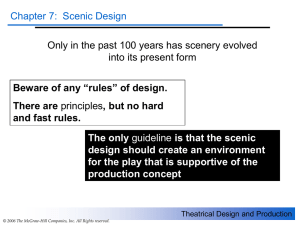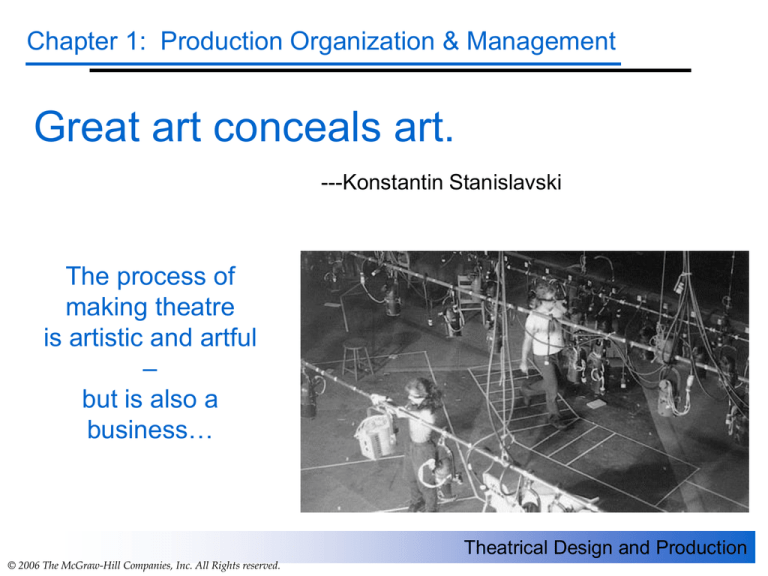
Chapter 1: Production Organization & Management
Great art conceals art.
---Konstantin Stanislavski
The process of
making theatre
is artistic and artful
–
but is also a
business…
Theatrical Design and Production
© 2006 The McGraw-Hill Companies, Inc. All Rights reserved.
Chapter 1: Production Organization & Management
The Production Sequence
– Script
• Assume you start with a text but not always!
– Develop the concept (a.k.a. ‘production
approach’)
• Production meetings
– Design the production
– Build/Construct the elements of the show
– Rehearsal Process
Theatrical Design and Production
© 2006 The McGraw-Hill Companies, Inc. All Rights reserved.
Chapter 1: Production Organization & Management
The Production Concept
The central creative idea that unifies the
artistic vision of the producer, director,
and designers.
Represents all ‘points of view’ involved in the creative process
Director controls the ‘unified vision’ of the whole
Designers create the pieces that support this world of the play
Theatrical Design and Production
© 2006 The McGraw-Hill Companies, Inc. All Rights reserved.
Chapter 1: Production Organization & Management
Production Meetings!
•Vital for smooth communication
•Forum for open discussion amongst designers
•Place to show sketches, ideas, and designs
•Initially only the designers and director
•Add stage manager and technical director once construction phase begins
Developmental
Informational
Communication is VITAL!!!
(Shift now to ‘remote conferencing’ due to technology)
Theatrical Design and Production
© 2006 The McGraw-Hill Companies, Inc. All Rights reserved.
Chapter 1: Production Organization & Management
The Rehearsal Process
Technical rehearsals
Devoted to integrating the sets, props, lighting, and sound with the
performers
Focus on discovering patterns and timing for cues and shifts
Shift rehearsals
Devoted to choreographing the scenery changes
Controlled by the stage manager, director, and technical director
Lighting rehearsals
Devoted to cueing the show – establishes timing and intensity
Precedes the first technical rehearsal
Dress rehearsals
Occurs during the end of ‘tech’ week
Incorporates the costumes into the process
Theatrical Design and Production
© 2006 The McGraw-Hill Companies, Inc. All Rights reserved.
Chapter 1: Production Organization & Management
Producer
Artistic Director
Scenic
Costume
Costume
Shop
supervisor
Lighting
Sound
Master
electrician
Playwright
Director
Sound
crew
Actors
Production Manager
Stage Manager
Stage
crew
Electricians
Wardrobe
run crew
Cutter/
draper
Costume
Crew
Managing Director
Props
master
Scenic
artist
Prop
Crew
Paint
Crew
Tech
Director
Shop
Foreman
Budget
Development
Box
Office
Scenic
Construction
Crew
Theatrical Design and Production
© 2006 The McGraw-Hill Companies, Inc. All Rights reserved.
Chapter 1: Production Organization & Management
The Producer
•Ultimate authority of the production
•Secures the rights
•Hires the director, designers, actors, & crews
Role varies depending on situation –
Broadway vs. Regional theatre vs. Educational theatre vs. Community/Non-Profit
Broadway – Producer is focused on single show only
Regional – Focused on season – often duties are split between
managing director and artistic director
Educational – Department chair often acts as managing director with
artistic duties split amongst a production committee made up of the faculty
Community / Non-Profit – Producer is usually a committee or board of
directors
Theatrical Design and Production
© 2006 The McGraw-Hill Companies, Inc. All Rights reserved.
Chapter 1: Production Organization & Management
The Playwright
Creates and develops the ideas that ultimately evolve into the
written script
If a living playwright, may be involved in initial rehearsals /
performances
Offers insight into characters
Interprets plot developments
Rewrites as needed
Often not available - so production team proceeds with
development and interpretation on their own
Theatrical Design and Production
© 2006 The McGraw-Hill Companies, Inc. All Rights reserved.
Chapter 1: Production Organization & Management
The Director
Artistic manager and inspirational leader of the production team!
Ultimately responsible for
the unified creative
representation of the play
–
From actors to designers,
the director has the
ultimate vision and the
ultimate veto power
Theatrical Design and Production
© 2006 The McGraw-Hill Companies, Inc. All Rights reserved.
Chapter 1: Production Organization & Management
The Production Manager
Coordinates the logistics of the production process from page to stage
Develops the production calendar and oversees major scheduling
Week
0
Week
4
Week
10
Week
11
Week
13
Rehearsals
Design
Performance
Construction
Technical and
dress rehearsals
Opening
Closing
Theatrical Design and Production
© 2006 The McGraw-Hill Companies, Inc. All Rights reserved.
Chapter 1: Production Organization & Management
The Stage Manager
Major communicator for the production process – 2 categories of duties:
1. Assisting the director during the rehearsal process
•
•
Conveys what occurs in rehearsal to the production team
Manages the actors and takes blocking
2. Being responsible for all backstage activity after the show opens
•
•
Orchestrates the technical rehearsals with the director and technical
director
Call the show – Light, sound, and scenic cues
Creates and maintains the prompt book – the ‘bible’ of the production
Theatrical Design and Production
© 2006 The McGraw-Hill Companies, Inc. All Rights reserved.
Chapter 1: Production Organization & Management
Scenic & Props
Scenic Designer: Responsible for the visual appearance and function of
the scenic and property elements used in the production
Scenic Artist: Paints the scenery
Paint Crew: Paints the sets and sometimes the props
Property Master: Responsible for the construction of all props in the play
Property Crew: Constructs or acquires the props for the play
Technical Director: Either a master craftsperson who builds the set or a
technical administrator
Scene-Shop Foreman: Responsible for the construction, mounting, and
rigging of the scenic pieces
Construction Crew: Responsible for building the set pieces and props
Stage Crew: Responsible for the running and maintenance of the set during
the technical rehearsals and performances
Theatrical Design and Production
© 2006 The McGraw-Hill Companies, Inc. All Rights reserved.
Chapter 1: Production Organization & Management
Lighting
Lighting Designer: Responsible for the design, installation, and
operation of the lighting and special electrical effects used in production
Asst. Lighting Designer: Responsible for producing and maintaining the
paperwork necessary to implement the designer’s vision
Master Electrician: Implements the lighting design – acquires, installs,
and maintains the equipment while supervising the crew
Electricians:
Hanging: Places instruments in place designated by the designer – circuits
and patches them as well
Focusing: Once in position the hanging crew focuses (aims) the lights and
puts in color media under the supervision of the designer
Running: Responsible for the operation and maintenance of the
instruments during the run of the production
Theatrical Design and Production
© 2006 The McGraw-Hill Companies, Inc. All Rights reserved.
Chapter 1: Production Organization & Management
Costumes
Costume Designer: Responsible for the visual appearance of the
actors
Costume Shop Supervisor: Builds (or supervises) the costumes as
specified by the designer
Costume Crew:
Cutter/Draper: Responsible for translating the designer’s sketches into
reality
First Hand: Supervises the construction of the garments
Stitchers: Construct the garments and do hand-sewing as needed
Dyers/painters: Dye and paint fabric as needed
Milliner: Constructs hats
Wigmaster: Makes, styles, and arranges wigs
Costume Craftsperson: Specialist that constructs period apparel
Wardrobe Supervisor: Responsible for all costumes during the run of the
production
Theatrical Design and Production
© 2006 The McGraw-Hill Companies, Inc. All Rights reserved.
Chapter 1: Production Organization & Management
Make-up
Make-up Designer: Responsible for the design and execution of makeup
Make-up Crew: Usually needed if people are required to execute
special make-up such as prosthetics and/or ‘effect’ make-up such as
scars or blood
Most often actors are responsible to put on their own make-up with the
approval of the costume designer.
Basic make-up is referred to as ‘street makeup’.
Theatrical Design and Production
© 2006 The McGraw-Hill Companies, Inc. All Rights reserved.
Chapter 1: Production Organization & Management
Sound
Sound Designer: Responsible for the design, recording, equipment setup, and playback of any sound used in the production.
Sound Crew: Responsible for the actual recording, editing, and
playback of sounds during rehearsals and performance
•Also responsible to run any sound reinforcement required for the
production
Theatrical Design and Production
© 2006 The McGraw-Hill Companies, Inc. All Rights reserved.

